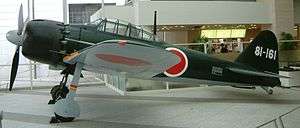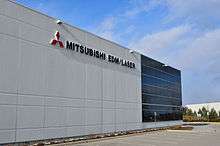Mitsubishi
 | |
| Private | |
| Industry | Conglomerate |
| Founded | 1870 |
| Founder | Iwasaki Yatarō |
| Headquarters | Tokyo, Japan |
Area served | Worldwide |
Key people | CEO, Ken Kobayashi |
| Products | Mining, shipbuilding, telecom, financial services, insurance, electronics, automotive, construction, heavy industries, oil and gas, real estate, foods and beverages, chemicals, steel, aviation and others |
| Services | 9 Jan 2000 |
| Revenue |
|
| Profit |
|
Number of employees | 350,000 (2010) |
| Subsidiaries | List of subsidiaries |
| Website |
Mitsubishi |
The Mitsubishi Group (三菱グループ, Mitsubishi Gurūpu) (also known as the Mitsubishi Group of Companies or Mitsubishi Companies) is a group of autonomous Japanese multinational companies[1] covering a range of businesses which share the Mitsubishi brand, trademark, and legacy.
The Mitsubishi group of companies form a loose entity, the Mitsubishi Keiretsu, which is often referenced in Japanese and US media and official reports; in general these companies all descend from the zaibatsu of the same name. The top 25 companies are also members of the Mitsubishi Kin'yōkai, or "Friday Club", and meet monthly. The Mitsubishi.com Committee facilitate communication and access to the Mitsubishi brand through a portal web site.[2]
History

The Mitsubishi company was established as a shipping firm by Yatarō Iwasaki (1834–1885) in 1870. In 1873, its name was changed to Mitsubishi Shokai. The name Mitsubishi (三菱) consists of two parts: "mitsu" meaning "three" and "hishi" (which becomes "bishi" under rendaku) meaning "water caltrop" (also called "water chestnut"), and hence "rhombus", which is reflected in the company's logo. It is also translated as "three diamonds".[3]
Mitsubishi was established in 1870, two years after the Meiji Restoration, with shipping as its core business. Its diversification was mostly into related fields. It entered into coal-mining to gain the coal needed for ships, bought a shipbuilding yard from the government to repair the ships it used, founded an iron mill to supply iron to the shipbuilding yard, started a marine insurance business to cater for its shipping business, and so forth. Later, the managerial resources and technological capabilities acquired through the operation of shipbuilding were utilized to expand the business further into the manufacture of aircraft and equipment. The experience of overseas shipping led the firm to enter into a trading business.[4]
In 1881 the company bought into coal mining by acquiring the Takashima Mine, followed by Hashima Island in 1890, using the production to fuel their extensive steamship fleet. They also diversified into shipbuilding, banking, insurance, warehousing, and trade. Later diversification carried the organization into such sectors as paper, steel, glass, electrical equipment, aircraft, oil, and real estate. As Mitsubishi built a broadly based conglomerate, it played a central role in the modernization of Japanese industry.[5]
In February 1921 the Mitsubishi Internal Combustion Engine Manufacturing Company in Nagoya invited British Sopwith Camel designer Herbert Smith, along with several other former Sopwith engineers to assist in creating an aircraft manufacturing division. After moving to Japan, they designed the Mitsubishi 1MT, Mitsubishi B1M, Mitsubishi 1MF, and Mitsubishi 2MR.
The merchant fleet entered into a period of diversification that would eventually result in the creation of three entities:
- Mitsubishi Bank (now a part of the Mitsubishi UFJ Financial Group) was founded in 1919. After its mergers with the Bank of Tokyo in 1996, and UFJ Holdings in 2004, this became Japan's largest bank.
- Mitsubishi Corporation, founded in 1950, Japan's largest general trading company
- Mitsubishi Heavy Industries, which includes these industrial companies:
- Mitsubishi Motors, the sixth-largest Japan-based car manufacturer.
- Mitsubishi Atomic Industry, a nuclear power company.
- Mitsubishi Chemical, the largest Japan-based chemicals company
- Mitsubishi Power Systems, a power generation division
- Nikon Corporation, specializing in optics and imaging.
The firm's prime real estate holdings in the Marunouchi district of Tokyo, acquired in 1890, were spun off in 1937 to form Mitsubishi Estate, now one of the largest real estate development companies in Japan.[6]
World War II

During the Second World War, Mitsubishi manufactured military aircraft under the direction of Dr. Jiro Horikoshi. The Mitsubishi A6M ("Zero") was a primary Japanese naval fighter in World War II. It was used by Imperial Japanese Navy pilots throughout the war, including in kamikaze attacks during the later stages. Allied pilots were astounded by its maneuverability, and it was very successful in combat until the Allies devised tactics to utilize their advantage in armor and diving speed.[7][8][9][10][11][12][13][14][15]
Mitsubishi made use of forced labor during this time period. Laborers included allied POWs, as well as Chinese citizens. In the post-war period, lawsuits and demands for compensations were presented against the Mitsubishi Corporation, in particular by former Chinese workers. On July 24, 2015, the company agreed to formally apologize for this wartime labor, and compensated 3765 Chinese laborers who were conscripted to Mitsubishi Mining during the war.[16] On July 19, 2015, the company apologized for using American soldiers as slave laborers during World War II, making them the first major Japanese company to apologize for doing so.[17]
Mitsubishi was involved in the opium trade in China during this period.[18]
Post-war era
Mitsubishi participated in Japan's unprecedented economic growth of the 1950s and 1960s. For example, as Japan modernized its energy and materials industries, the Mitsubishi companies created Mitsubishi Petrochemical, Mitsubishi Atomic Power Industries, Mitsubishi Liquefied Petroleum Gas, and Mitsubishi Petroleum Development.
The traditional Mitsubishi emphasis on technological development was in new ventures in such fields as space development, aviation, ocean development, data communications, computers, and semiconductors. Mitsubishi companies also were active in consumer goods and services.
In 1970, Mitsubishi companies established the Mitsubishi Foundation to commemorate the centennial anniversary of the founding of the first Mitsubishi company. The companies also individually maintain charitable foundations. Mitsubishi pavilions have been highlights of expositions in Japan since EXPO'70 in Osaka in the 1970s to 1980s.
In the early 2000s, after the merger of several companies, the Mitsubishi Tanabe Pharma group came to include the former Green Cross Corporation.
As of 2007, Mitsubishi Corporation, a member of the Mitsubishi Group, is Japan's largest general trading company (sogo shosha) with over 200 bases of operations in approximately 80 countries worldwide. Together with its over 500 group companies, Mitsubishi employs a multinational workforce of approximately 54,000 people.
Mitsubishi Motors reached 1.3 million cars of total production in 2007.
In January 2013, Mitsubishi announced it would be launching a takeover bid for the Japanese meat processor Yonekyu Corp in a deal worth $197 million.[19]
In May 2014, Germany’s Siemens announced it had signed a deal to enter a joint venture with Mitsubishi Heavy Industries to provide plants, products and services for the metals industry. The joint venture is 51% owned by Mitsubishi, while the remaining stake is held by Siemens.[20]
In October 2014, Mitsubishi acquired 91 percent of the Norwegian salmon farming firm Cermaq for $1.4 billion.[21]
Mitsubishi companies

Business form
The Mitsubishi Group is made up of about 40 individual companies with no controlling parent company. Each of the Mitsubishi companies owns substantial portions of the shares of the others. Instead of a parent company exercising control over subsidiaries, the group operates under the direction of a triumvirate of the three most important sister companies: the Mitsubishi Bank, the Mitsubishi Corporation, and Mitsubishi Heavy Industries. The senior managers of these three companies act as the co-chairman of a coordinating board called the Kinyo-Kai, or Friday Conference. The Kinyo-Kai, which is made up of the top executives of 25 of the Mitsubishi companies, establishes common policies as a sort of senior board of directors for the entire group.
Core members
- Asahi Glass Co.
- The Bank of Tokyo-Mitsubishi UFJ
- Kirin Company
- Meiji Yasuda Life
- Mitsubishi Corporation
- Mitsubishi Electric
- Mitsubishi Estate
- Mitsubishi Heavy Industries
- Mitsubishi Materials
- Mitsubishi Logistics
- Mitsubishi Motors (Automobile manufacturing and sales)
- Mitsubishi Paper Mills
- Mitsubishi Plastics
- Mitsubishi Rayon
- Mitsubishi Research Institute
- Mitsubishi Shindoh
- Mitsubishi Steel Manufacturing
- MSSC
- Mitsubishi UFJ Trust and Banking Corporation (part of Mitsubishi UFJ Financial Group)
- Mitsubishi UFJ Securities
- Nikon
- Nippon Oil
- NYK Line (Nippon Yusen Kabushiki Kaisha)
- P.S. Mitsubishi Construction
- Tokio Marine Nichido
These companies are members of the Mitsubishi Kinyokai (Friday Club), and meet monthly.
Nikkei 225 member companies
- Asahi Glass Co.
- Kirin Company
- Mitsubishi Electric
- Mitsubishi Estate
- Mitsubishi FUSO Truck & Bus Corp.
- Mitsubishi Heavy Industries
- Mitsubishi Logistics
- Mitsubishi Materials
- Mitsubishi Motors
- Mitsubishi Paper Mills
- Mitsubishi UFJ Financial Group
- Nikon
- Nippon Yusen
Related organizations

- Atami Yowado
- Chitose Kosan
- Dai Nippon Toryo
- The Dia Foundation for Research on Ageing Societies
- Diamond Family Club
- Kaitokaku
- Koiwai Noboku Kaisha
- LEOC Japan
- Marunouchi Yorozu
- Meiwa Corp.
- Mitsubishi C&C Research Association
- Mitsubishi Club
- Mitsubishi Corporate Name and Trademark Committee
- Mitsubishi Economic Research Institute
- Mitsubishi Electric Automation
- Mitsubishi Foundation
- Mitsubishi Kinyokai
- Mitsubishi Marketing Association
- Mitsubishi Motors North America
- Mitsubishi Public Affairs Committee
- The Mitsubishi Yowakai Foundation
- MT Insurance Service
- Nippon TCS Solution Center
- Seikadō Bunko Art Museum
- Shonan Country Club
- Sotsu Corporation
- Tōyō Bunko
- Seikei University
- All Mitsubishi Lions
See also
References
- ↑ About Mitsubishi. mitsubishi.com. Retrieved on 2013-08-16.
- ↑ Mitsubishi.com Committee
- ↑ The Mitsubishi Mark
- ↑ Odagiri, Hiroyuki (1996). Technology and Industrial Development in Japan. Oxford University Press. p. 76. ISBN 0-19-828802-6.
- ↑ "The History of Mitsubishi Group". GearHeads. 19 May 2012. Retrieved 25 October 2012.
- ↑ "History". Mitsubishi Estate Co., Ltd. Retrieved 7 September 2015.
- ↑ Wilcox, Richard (9 November 1942). "The Zero". Life Magazine.
- ↑ Jablonski, Edward. Airwar. New York: Doubleday & Co., 1979. ISBN 0-385-14279-X.
- ↑ Green and Swanborough 2001
- ↑ Hawks, Chuck. "The Best Fighter Planes of World War II". chuckhawks.com. Retrieved: 30 July 2015.
- ↑ Young, Edward M. (2013). F4F Wildcat vs A6M Zero-sen. Osprey Publishing. p. 36. ISBN 9781780963228.
- ↑ Thompson with Smith 2008, p. 231.
- ↑ Mersky, Peter B. (Cmdr. USNR). "Time of the Aces: Marine Pilots in the Solomons, 1942–1944." ibiblio.org. Retrieved: 30 July 2015.
- ↑ Angelucci and Matricardi 1978, p. 138.
- ↑ Willmott 1980, pp. 40–41.
- ↑ http://articles.economictimes.indiatimes.com/2015-07-24/news/64817007_1_mitsubishi-materials-chinese-victims-compensation
- ↑ "Mitsubishi Materials apologizes for using U.S. POWs as slave labor". Reuters. 20 July 2015. Retrieved 19 July 2015.
- ↑ Hastings, Max (2007). Retribution. New York: Vintage. p. 413. ISBN 978-0-307-27536-3.
- ↑ Reuters (18 January 2013). "Mitsubishi Corp to launch $197 million takeover bid for Yonekyu". Reuters.
- ↑ Siemens, Mitsubishi Heavy form metals joint venture, International: Reuters, 2014
- ↑ Mitsubishi gets 91 percent of Cermaq in bid. Reuters, 21 October 2014
External links
| Wikimedia Commons has media related to Mitsubishi. |
- Portal website for Mitsubishi companies
- Mitsubishi companies grouped at OpenCorporates
- Official Mitsubishi UAE Website
| ||||||||||||||||||||||||||||||||||||||||||||||||||||||||||||||||||||||||||||||||||||||
| ||||||||||||||||||||||